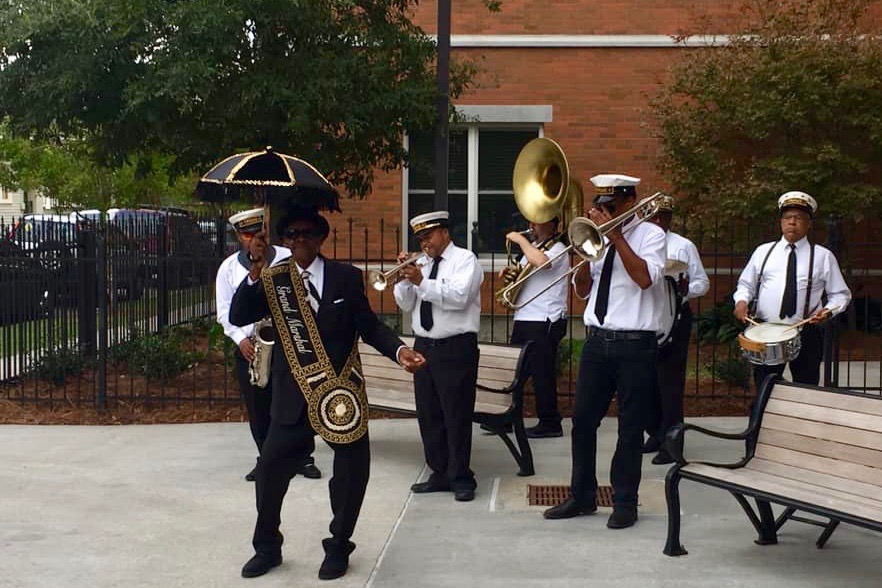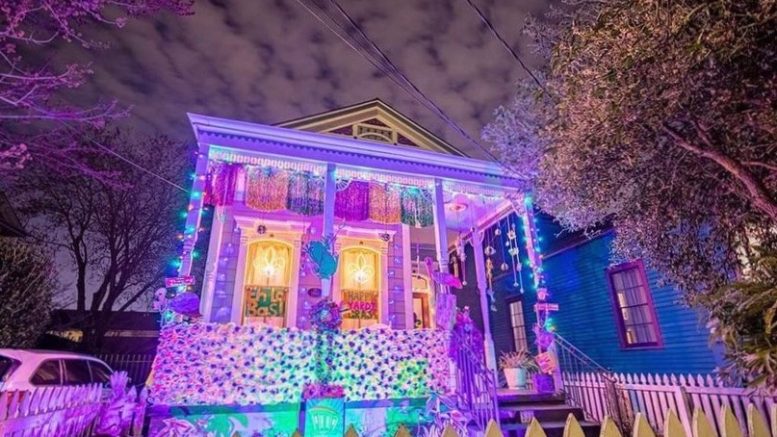Time dies when kettle lamps are flickering against the darkened planks of a Creole cottage in Algiers Point. There’s no sense of movement – there’s just river ships haunting the fog and rain. There’s just a trace of voices and notes that once played over the gale-torn levee.
One of New Orleans’ oldest neighborhoods, Algiers stands on a bend in the Mississippi River across the waves from The Bywater, The Marigny, The French Quarter and the Crescent City’s towering business district. It has rows of Victorian bungalows dating back to the first men of Jazz. It features a glass-blowing gallery that’s housed in an aged, Art Deco movie palace. It hides a folk-art museum speaking to the soul of the Afro-Caribbean experience around the point, from early voodoo drum pounding to the city’s rhythmic collision of Delta blues and church hymns.
Algiers is also one of the best places to sky-watch during a true Louisiana storm.
Are monsoons different in the Bayou State? To an outsider they are. Those sudden thunderheads come off the swamps like bulwarks devouring what’s left of the spectral light over the Mississippi. It can seem like their low, tumbling clouds heave with the color of burnt oyster shells. It’s an empyrean show; but it takes more than a bit of weather to stop the ferry heading to Algiers Point. The boat runs like clockwork every thirty minutes from the Canal Street terminal, even when a high shadow is drawing from the east-bank hotels to the west edge of the river. The ferry’s been steadily plowing through the currents this way since 1827.
Its launch to Algiers is an eight-minute stroll from the French Quarter; and if one’s looking for the splendor of a New Orleans storm, then that walk has sights all its own. Rain veils the arteries of this European other-world with drops brushed by an uncanny haze from its battered porch lights. The sky’s balmy breath practically clings to the district’s old mortar and writhing balcony rails. The path down Royal Street is especially dreamlike, with falling spray that dances by the funerary reach of its storm shutters, and the weather’s shape curtaining down the corridor of tiny gas-flames blinking in ebony lamps – their amber flashes leaving a spell on the long vines that hang from galleries. Occasionally, one passes a courtyard where a lizard is ripping down the green shield of a banana leaf, jumping onto the tiles of a fountain and scurrying through droplets that pound its emerald water basin.
“New Orleans was the embodiment of the Romantic notion … indissolubly linking beauty and sadness, beauty and decay, beauty and pain, beauty and death. La Ville Fatale. But, more significantly, it was ‘the divine breath of the ocean’ that ineluctably drew the sea-bewitched Lafcadio to this southern port.” – Jonathan Cott, ‘Wandering Ghost’
After boarding the ferry, it’s a matter of experiencing the storm from the whitecaps of the Mississippi. Out on its tide, the muted hints of lightning are genuine magic. The strength of the river goes gently rocking through the hull. The ship’s deck reveals thunderclaps making grass on Algiers’ distant levee come alive. Beyond the stern, lashes of electricity can be glimpsed clipping from mid-river to the slanted, Spanish-era chimneys of The Quarter. It’s storm-watching the way that early seafarers originally saw it here on the Gulf.
Stepping off the ferry at Algiers Point means arriving at a storied but quiet area referred to as the hidden gem of New Orleans. Its panoramic views on the greater city are spirit-lifting, whether a storm is adding its alchemy or not. There’s a sightline down Algiers’ levee where volleys of grey whipping water tangoed around the statue of Louie Armstrong. It’s a little surreal – tree branches drumming behind Satchmo’s smile, his eyes closed in emerald rust, his outstretched trumpet cutting the violent drizzle.
The Jazz Walk itself is mesmerizing when its assailed by a storm. It conjures a sense of noir for eyeing the titanic jaws of passing boats, or rain birds gliding through the gusty greyness. In a hard downpour, the cement of the walkway looks like sky diamonds burning on glass under tall, tin river-lamps.
Wandering off the levee will lead to Algiers’ neighborhoods. They make a cozy, cluttered scene in the storm-shadow, their cottages lit by naked bulbs burning against storm shutters as plants are thrashing over the wet doorsteps. And it’s just the nuances – big drips falling like brushes over a snare drum. On Morgan Street, the run-off is pouring from the Richardsonian Romanesque window-arches of the 127-year-old courthouse. The Old Masonic Hall and Mount Olivet Church are just as transporting.
One oral tradition holds that Buddy Bolden, the trumpeter who created the first notes of Jazz – a figure who now dwells in the borderland cabarets of myth and history – cracked his mind in half while playing in a funeral march here at Algiers Point. It’s well-documented that Bolden spent the last years of his life in the Louisiana State Insane Asylum; but whether his public breakdown happened while blasting his horn ahead of coffin in Algiers in 1907, as Jazz musician Danny Barker wrote, or during New Orleans’ Labor Day Parade on Canal Street in 1906, is a topic that is still debated by scholars. What is not debated is that Bolden sometimes played here in Algiers, where it was said that he blew his coronet so loud it could be heard across the river in the French Quarter.
“There was no control except the mood of his power… and it is for this reason it is good you never heard him play someplace where the weather for instance could change the next series of notes— then you should never have heard him at all. He was never recorded. He stayed away while others moved into wax history, electronic history, those who said later that Boldon broke the path. It was just as important to watch him stretch and wheel around the last notes or to watch nerves jumping under the sweat of his head.” – Michael Ondaatje, ‘Coming Through Slaughter’

Those looking to get dry in Algiers find their haven in the Drydock Café. The place is a quick trot down the levee from where the ferry lands. A staple for 34 years, the Drydock feels older than that, a cubby of red bricks and dusty boat wheels that gradually warms the spine – its bar’s battery of rum bottles set against the iron curve of a rising staircase. Few sights are more relaxing than seeing one of its cooks tromp in from the rain with a bucket of ice under his arm, the door behind swatting in the wind near the model clipper ship.
From there, it’s the smell spiced butter spitting under seafood and a little blue flame in the back. They’ll bring out oyster po’ boys, Cajun shrimp appetizers or mouthwatering Crawfish pasta. Storm-watchers can calm themselves with this comfort food and a beer while waiting for the café’s door to bat open again. The Drydock is a place that hosts live music and neighborhood parties, and the warm feelings here carry on into Algiers’ other drinking dens, the Old Point Bar and the Crown & Anchor Pub.
These are joints where locals make the regalia run high on Halloween, Saint Patrick’s Day and Fat Tuesday. They’re places that celebrate nearly the whole world in the microcosm of one slightly unsinkable city. In an understated way, their weather-beaten existence honors the area’s first melting of French, Spanish, African, Caribbean and Choctaw Indian cultures. The little touches of the surrounding streets hail what came next, the German bakers and Sicilian grocers and Irish canal-diggers who kept New Orleans’ ethnic extravagance growing bigger by the decade. It’s a place where heritage is infectious, shape-shifting and perpetual. And for all those reasons, it’s inspiring to watch even the most sublime storms eventually lose their fight against it.
“Life here is so lazy – nights are so liquid with tropic moonlight – days are so splendid with green and gold – summer is so languid with perfume and warmth – that I hardly know whether I am dreaming or awake. It is all a dream here, I suppose, and will seem a dream even after the sharp awakening of another voyage.” – Lafcadio Hearn, Letters about New Orleans
Scott Thomas Anderson is also the writer-producer of the ‘Drinkers with Writing Problems’ podcast, Episode 3 of which was written and recorded in the city of New Orleans.


Be the first to comment on "Storm-starring from Algiers Point in New Orleans"